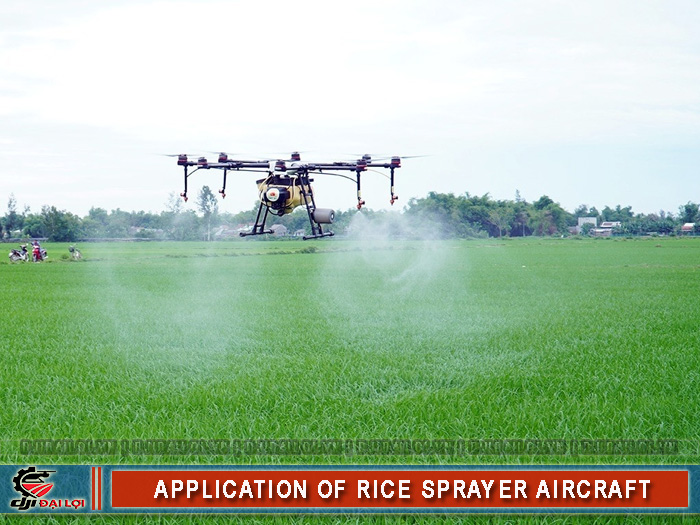
Why farmers are interested in rice-spraying drones
In traditional rice farming, farmers must wade through muddy fields carrying heavy sprayers, directly exposed to chemicals. This process is time-consuming, labor-intensive, and harmful to health.
With drone technology, however, the image of a rice-spraying drone flying steadily above the field - covering entire hectares in minutes without touching the ground - sparks curiosity and optimism. Farmers begin to ask:
- Is it truly effective and safe?
- Does it actually reduce costs?
- Can it work for my field conditions?
These questions reflect a very real need to shift from manual labor to intelligent mechanization - a vital direction for sustainable, modern agriculture.
Five criteria for evaluating drone spraying efficiency
To answer “Are rice-spraying drones truly effective?”, we can assess them using five key criteria:
1. Coverage capacity and working speed
A medium-capacity drone can spray 10–20 hectares per day - 20–30 times faster than manual spraying. The speed advantage ensures timely pest control during critical outbreak stages.
2. Accuracy and uniformity
Smart flight control systems adjust altitude and speed automatically to ensure precise and even spraying. Pesticides and fertilizers are applied in the right dose, minimizing drift, evaporation, and environmental impact.
3. Cost and labor savings
Drone spraying cuts water and chemical use, reduces spraying time, and eliminates most manual labor. The cost per hectare is typically 20–40% lower than traditional spraying.
4. Safety for operators
Operators no longer enter fields or handle chemicals directly, greatly reducing the risk of pesticide poisoning - an important factor for sustainable agricultural production.
5. Adaptability to complex terrains
Rice-spraying drones perform well even in fragmented fields, small plots, or areas inaccessible by large tractors - conditions where traditional equipment struggles.
Pros and cons of using rice-spraying drones
Main advantages
- Exceptional efficiency: fast, even, and precise spraying reduces chemical waste.
- Significant cost reduction: savings on labor, water, and time.
- Worker safety: no direct contact with pesticides.
- Flexible application: suitable for small and medium-scale farms.
- Environmentally friendly: minimizes residue and protects the field ecosystem.
Drawbacks to consider
- High initial cost: a quality agricultural drone costs about 150–300 million VND.
- Requires technical training: operators must be trained in flight, spraying, and maintenance.
- Weather-dependent: strong wind, rain, or high humidity can affect spraying quality.
- Legal restrictions: in some areas, flight registration and permits are required.
Real-world results of using rice-spraying drones
In Vietnam
- In Dong Thap, drone spraying reduced water use by over 90% and saved 30–50% in spraying costs.
- Farmers report: “It used to take 2–3 hours of walking through the field - now it’s done in 10 minutes with a drone.”
Globally
- Countries like China, Japan, and South Korea have widely adopted agricultural drones.
- Brands such as DJI, XAG, and Yamaha report up to 35% higher productivity and 25–50% lower operational costs compared to manual spraying.
Overall benefits
- Yields increase by 10–15% through precise and timely spraying.
- Pest infestation rates drop significantly.
- Compatible with organic and clean farming standards for export markets.
When to use or not use rice-spraying drones
- Farms from 3–10 hectares → Suitable for investment or cooperative drone-sharing; ROI achievable in 1–2 crop cycles.
- Farms under 2 hectares → Not cost-effective for individual ownership; hiring drone services is more practical.
- Fields with small plots and canals → Drones excel in these environments, spraying quickly and evenly without requiring ground equipment.
- Certified or GlobalGAP production → Using drones helps control pesticide residue and meet international safety standards.
Cost, regulations, and usage trends for rice-spraying drones
Investment and service cost overview
|
Category
|
Estimated Cost
|
|
Purchase of agricultural drone
|
150–300 million VND
|
|
Operator training
|
5–10 million VND/person
|
|
Spraying service fee
|
150,000–300,000 VND/ha per session
|
|
Maintenance (battery, parts)
|
10–20 million VND/year
|
Legal requirements in Vietnam
- Drones must be registered with local authorities.
- Operators must hold certified drone operation licenses (training provided by agricultural extension centers or plant protection institutes).
- Flight altitude must remain below 120 meters and avoid populated or restricted areas.
Future trends
- Integration of AI and digital mapping for precision spraying.
- Rapid growth of professional spraying services in the Mekong Delta, Central Highlands, and northern regions.
- Wider adoption by cooperatives and clean rice production chains.
Conclusion
Rice-spraying drones are not just a modern trend but a truly effective, safe, and cost-efficient solution for sustainable agriculture. Their use helps reduce costs, minimize risks, and boost productivity - aligning perfectly with the future of precision farming. However, to achieve the best results, farmers should choose the right scale, timing, and ensure proper technical operation.
FAQs about rice-spraying drones
Which chemicals can rice-spraying drones apply?
They can spray pesticides, herbicides, foliar fertilizers, and growth regulators, provided the solutions are liquid and mixed correctly.
Can operators create custom flight maps for drone spraying?
Yes. Most modern drones include mapping software that allows automatic flight route planning via smartphone or tablet.
What is the best time of day to use rice-spraying drones?
Early morning or late afternoon is ideal, with low wind, stable humidity, and reduced evaporation.
How often should drones be maintained?
Inspect propellers, nozzles, batteries, and sensors every 10–15 operating hours to ensure safety and precision.
Can the same drone be used for other crops?
Yes. Many models can adjust altitude and spray volume for crops like vegetables, corn, sugarcane, coffee, and pepper.
